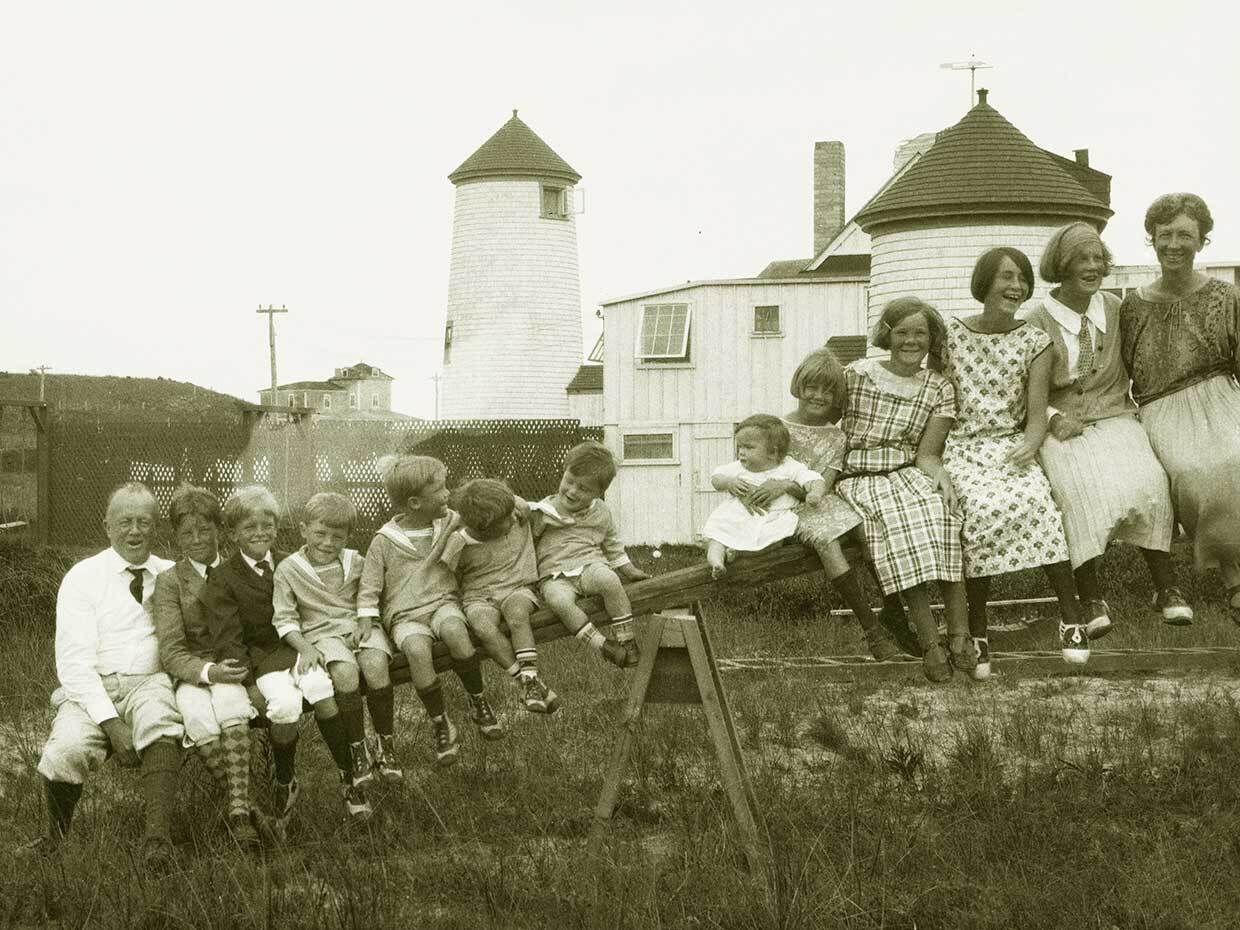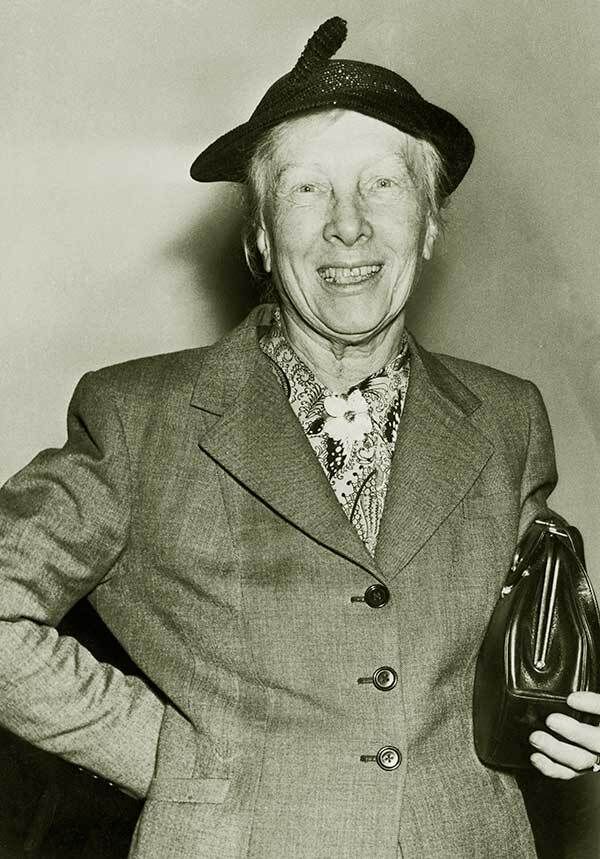Learn who we have to thank for the term "Work-Life Balance"
| Author: | Lisa Nocks, IEEE |
|---|

The Gilbreth family sits atop a see-saw while they spend their 1923 summer in an old lighthouse on Nantucket Island.
THE INSTITUTE
Lillian Moller Gilbreth’s contributions to industrial engineering and to society were recognized by many honors and awards conferred on her in her lifetime. For encouraging women to seek careers in engineering, in 1958 the Society of Women Engineers named its first scholarship after her. In 1965 she became the first woman elected to the National Academy of Engineering. In 1966 she was awarded the Hoover Medal, established in 1929 to recognize engineers’ civic and humanitarian achievements—an honor jointly conferred by the American Society of Mechanical Engineers, the American Society of Civil Engineers, the American Institute of Chemical Engineers, the American Institute of Mining, Metallurgical and Petroleum Engineers, and our own IEEE. They acknowledged her to be a:
… renowned engineer, internationally respected for contributions to motion study and to recognition of the principle that management engineering and human relations are intertwined; courageous wife and mother; outstanding teacher, author, lecturer, and member of professional committees under [U.S. President] Herbert Hoover and four successors. Additionally, her unselfish application of energy and creative efforts in modifying industrial and home environments for the handicapped has resulted in full employment of their capabilities and elevation of their self-esteem.
The general public knew Gilbreth—who died in 1972—differently: as a “supermom” who assisted her husband, Frank Bunker Gilbreth, during his workplace-efficiency studies while she raised a large family.
But that characterization arose from a comical 1950 film version of a Gilbreth family memoir, Cheaper by the Dozen. Lillian (played by Myrna Loy) is shown tolerating her husband’s eccentric behavior as he enlisted his children as test subjects. She timed or filmed family activities—including a production-line tonsillectomy session performed in their home. Loy’s Lillian is level-headed and articulate, yet a traditional “model” woman: devoted mother and wife and perennial assistant to the “great man,” who is the real brains behind the operation.
In reality, Frank Gilbreth (who never attended college, though he had been accepted to MIT) respected his wife as an intellectual and as a business partner. She already had earned a master’s degree in literature from the University of California, Berkeley, and was working toward a doctorate in psychology when the couple married in 1904. Her doctoral dissertation, The Psychology of Management: The Function of the Mind in Determining, Teaching, and Installing Methods of Least Waste, formally integrated human factors such as physical comfort, job satisfaction, the feeling of usefulness, and job security into workplace-efficiency principles.
PUTTING WORKERS FIRST
Together the Gilbreths ran a construction firm Frank had established in Boston in 1895. His systematic approach had delivered construction projects ahead of time and under budget; his inventions, including an adjustable bricklayer’s scaffold patented in 1896, and his 1908 book Field System had made Gilbreth and Co. successful.
Around 1912, after a downturn in the construction industry, the Gilbreths devoted their business entirely to promoting their version of “scientific management.” The term was coined in 1910 by Justice Louis Brandeis to describe principles and systems of business management meant to improve worker productivity. The principles had been independently developed a decade earlier by Frank Gilbreth and mechanical engineer Frederick Winslow Taylor.
The couple integrated filmed motion studies in their research, recording and timing each phase of a worker’s movement on the job to determine its efficiency and to observe points of fatigue. They coauthored numerous books, and they ran summer graduate courses in scientific management.
Lillian did not qualify for the Ph.D. from the University of California on a residency technicality, but her research was published as a series of articles in Industrial Engineer magazine in 1912 and 1913, and then as a book in 1914.
It was during that time that her conviction of the importance of addressing the psychological and emotional aspects of labor became a guiding force in the couple’s work. The Gilbreths had helped found the Taylor Society to promote scientific management, but by 1914, a year before Frederick Taylor died, they parted philosophically with him over his focus on time-saving over worker welfare.
In 1915 Lillian qualified for a Ph.D. in psychology at Brown University, in Providence, R.I., where the family lived. Her dissertation, The Elimination of Waste in Teaching, adapted the psychological aspects of scientific management to classroom teaching. It also inspired a collaborative effort to develop a course for teaching time and motion studies and scientific management. The work contributed to ideas for the summer schools teaching scientific management that the couple ran in Providence.
Lillian’s graduate work continued to influence the direction of the Gilbreths’ research and business for the next decade, while the family lived in Montclair, N.J. The curriculum they developed was at the heart of the speech Frank was to give in Prague at the First International Management Congress. In the movie, when Frank dies suddenly of a heart attack (as he actually did, on 14 June 1924) Lillian consults her children about whether she should go to Prague to read his speech. In reality, the couple had planned to travel together all along. Although Lillian had some misgivings about how a female presenter would be received, the speech she read on teaching scientific management was the result of the couple’s collaboration. Within a year of Frank’s death, she was running the course from her home in Montclair.
FROM INDUSTRY TO HOME

Cheaper by the Dozen shows Lillian always at home. But aside from giving birth to 13 children (one daughter was still-born), the real Lillian was not a traditional, domestic type. She had grown up in a household run by servants, and she and Frank employed a handyman and a cook. Adapting scientific management principles to the running of their large household suited her preference for intellectual and business pursuits over homemaking.
Ironically, after Frank’s death, Lillian was engaged by companies promoting kitchen efficiency—mainly to sell their own products—and she found herself designing kitchens. Her Kitchen Practical model, which illustrated her vision of an ideal circuit between the stove, sink, and refrigerator to reduce movement and fatigue, was exhibited by the Brooklyn Borough Gas Co. at the 1930 Exposition of Women’s Arts and Industries, in New York City. She also consulted for General Electric, arguing that allowances for differences in worker height and ability should be considered, and rejecting the standardized heights for countertops that were eventually adopted by designers.
She saw homemaking as a job that should be managed efficiently, as with any other business. She envisioned the ideal kitchen with an office workstation for inventories and record-keeping. The Gilbreth Management Desk was exhibited by IBM at the 1933 Century of Progress Exposition in Chicago. To have all the tools at hand, designed, and arranged for convenience, comfort, productivity, and satisfaction was as essential to the home as to the bank, factory, or classroom. We can imagine Lillian of the 21st century embracing laptops, the Internet, and software such as Jive and QuickBook as useful home office tools.
Lillian Gilbreth was by no means the only woman to engage in adapting scientific-management principles to the home, or even to assert the importance of the psychological impact of work. Christine Frederick, for example, articulated similar ideas in The New Housekeeping (1913). But the Gilbreths, by applying time and motion studies and precise data recording in their publications, moved the study of home management from the anecdotal to the scientific.
The Gilbreths’ association with other scientific management proponents provided Lillian a professional environment in which to advance her humanistic approach to efficiency.
Lillian’s work perhaps is better known today than other women who promoted the efficient household because of her association with her husband, but also because she moved among influential people who recognized her work. As part of the inner circle of Herbert Hoover’s administration, and in response to her concerns over unemployment, she was appointed director of the women’s division of President Hoover’s Emergency Committee on Employment in 1930.
She was also appointed a visiting professor of management at the Purdue University school of industrial engineering, in Lafayette, Ind., in 1935. On her retirement in 1948, the school awarded her an honorary doctorate in industrial engineering.
At the 1957 Society of Women Engineers conference, she reasserted her concern that business leaders should consider what would become of displaced workers as a result of automation. She applauded new initiatives for vocational training for semi- and non-skilled workers, and she highlighted the importance of hiring disabled veterans. She defended the retention of older workers, whose extensive experience offers its own benefit to the goal of efficiency.
Cheaper by the Dozen obscures Lillian Gilbreth’s contributions to industrial engineering and to society in general. She identified as essential the sense of gratification that comes with productive work and recognition of a job well done. By linking the psychological aspects of labor with the physical productivity that efficiency experts called for, in connecting time management to reduced stress, and in recognizing the efficiently run home as a job, she established the philosophical basis for what we now call work-life balance. The concept took hold as more women entered the workforce and were put in positions of authority, and as men took a more active role in home and family duties.
Writer, Lisa Nocks, is a historian at the IEEE History Center.
Related Link: https://spectrum.ieee.org/the-institute/ieee-history/learn-who-we-have-to-thank-for-the-term-worklife-balance
